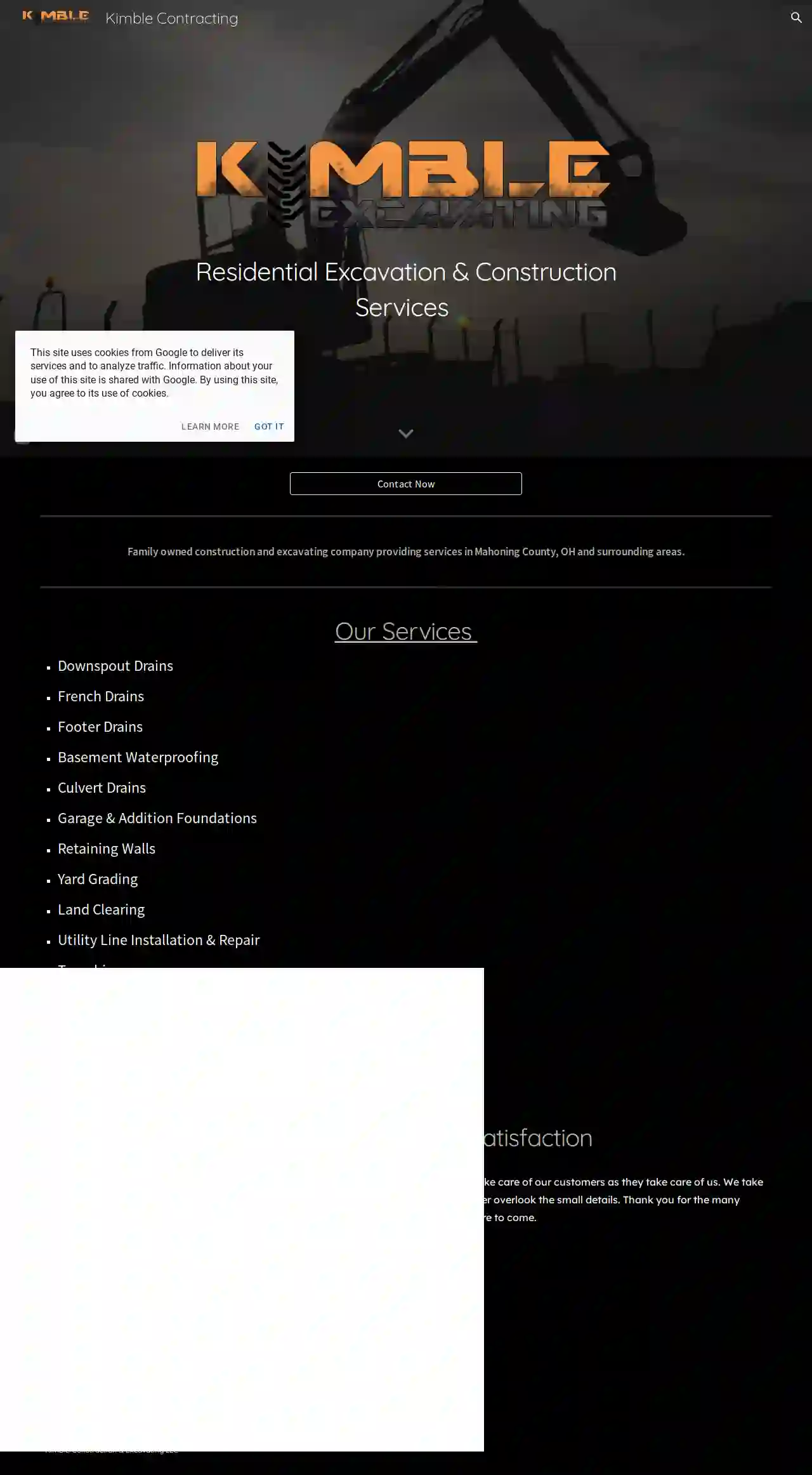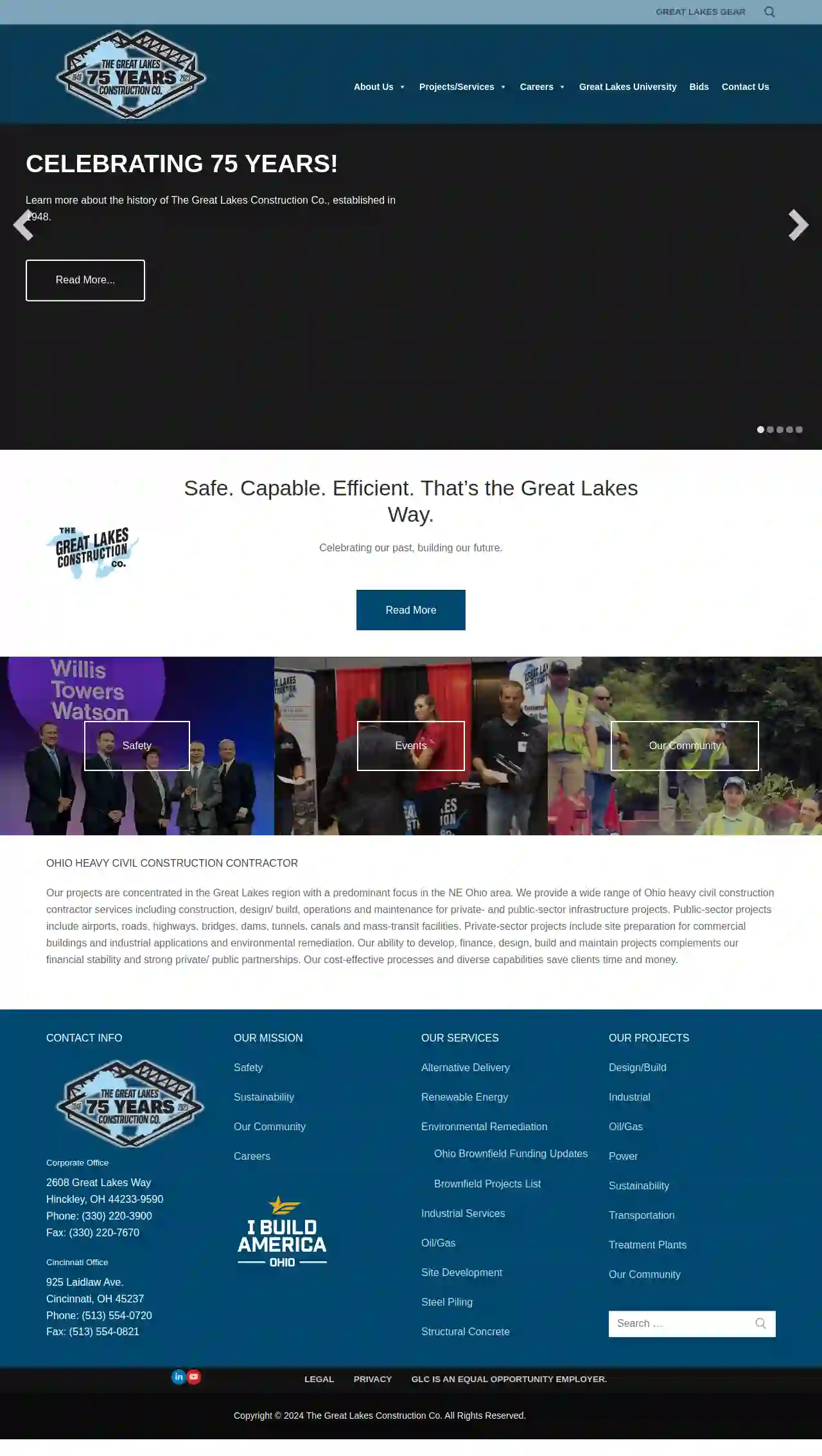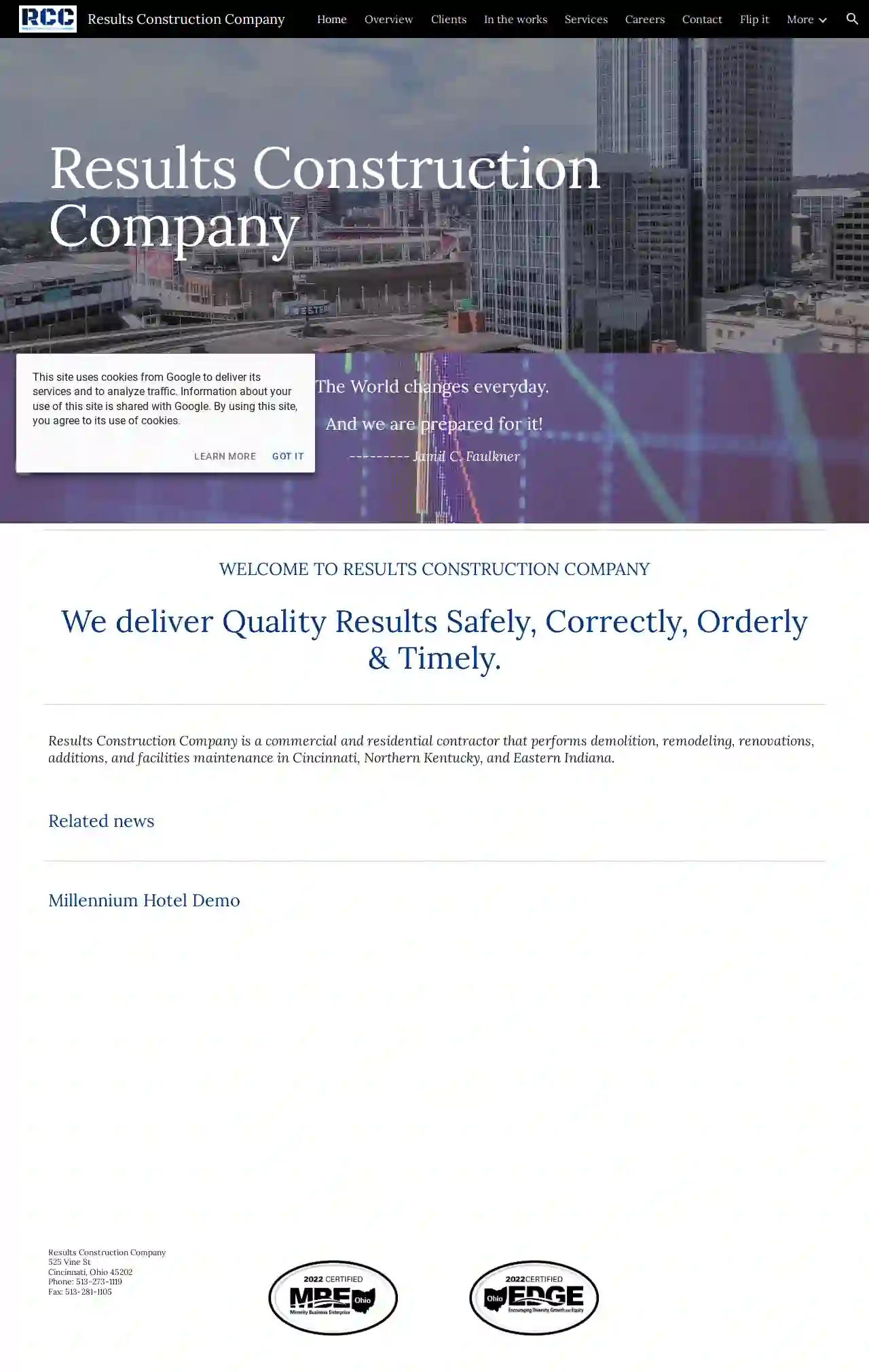Excavation Contractors Cedarville
Top 10 Excavation Contractors Near Me in Cedarville
Receive multiple Excavating Contractor quotes for your project today! Compare profiles, reviews, accreditations, portfolio, etc... and choose the best deal.

Kimble Construction & Excavating
53 reviewsYoungstown, USKimble Contracting: Your Trusted Partner for Residential Excavation and Construction Kimble Contracting is a family-owned construction and excavating company serving Mahoning County, OH, and surrounding areas. We are dedicated to providing high-quality services with a focus on customer satisfaction. Our team takes pride in our work and pays meticulous attention to detail, ensuring your project is completed to the highest standards. We understand the importance of building strong relationships with our clients. As a small business, we treat our customers like family, providing personalized attention and exceptional service. We are committed to exceeding your expectations and delivering projects on time and within budget. Thank you for considering Kimble Contracting for your next project. We look forward to working with you!
- Services
- Why Us?
- Our Team
- Gallery
Get Quote
Ohio Valley Excavating
38 reviewsLebanon, OH, USWho We Are Founded in 2004, Ohio Valley Excavating (OVE) delivers full-service excavation solutions in the electrical and communications industries for private, public, and federal sectors. OVE's capabilities include providing the end-users with a turn-key solution for underground electrical and communication infrastructure. OVE is headquartered in Lebanon, OH and services the Midwest. Our History Founded: 2004 Joined Congruex: 2021
- Services
- Why Us?
- Gallery
Get Quote
Great Lakes Construction
51 reviews2608 Great Lakes Way, Hinckley, 44233-9590, USCelebrating 75 Years! Learn more about the history of The Great Lakes Construction Co., established in 1948. Read More... The Great Lakes Construction Co. 75th Anniversary Timeline Explore the milestones and achievements that have shaped our journey. Read More... CO-OP/INTERNSHIP PROGRAM Great Lakes believes that Co-op programs serve as a great foundation for the student’s career path. Currently, 30 former co-ops have accepted permanent positions in our company including our President and Vice President of Operations. Read More... OHIO BROWNFIELD FUNDING UPDATES Ohio’s new operating budget calls for an investment of $500 million in brownfield revitalization, including $350 million dedicated to site cleanup and $150 million for demolition. Read More... CLINTON STREET BRIDGE REPLACEMENT Project 538-18 consisted of removing the existing 429 foot six-span concrete box beam bridge and replacing it with a 466 foot five-span continuous steel beam bridge. Read More... Safe. Capable. Efficient. That’s the Great Lakes Way. Celebrating our past, building our future. Read More Safety Safety is our top priority. We are committed to providing a safe and healthy work environment for our employees and the public. Events Stay up-to-date on our upcoming events and industry news. Our Community We are proud to be a part of the communities we serve. We are committed to giving back and making a positive impact. Ohio Heavy Civil Construction Contractor Our projects are concentrated in the Great Lakes region with a predominant focus in the NE Ohio area. We provide a wide range of Ohio heavy civil construction contractor services including construction, design/ build, operations and maintenance for private- and public-sector infrastructure projects. Public-sector projects include airports, roads, highways, bridges, dams, tunnels, canals and mass-transit facilities. Private-sector projects include site preparation for commercial buildings and industrial applications and environmental remediation. Our ability to develop, finance, design, build and maintain projects complements our financial stability and strong private/ public partnerships. Our cost-effective processes and diverse capabilities save clients time and money.
- Services
- Why Us?
- Gallery
Get Quote
High Country Excavation, LLC - Landscape Excavator Service & Demolition Excavation Contractor
57 reviewsHigh Country Excavation, LLC, Lakewood, CO, 80235, USAbout High Country Excavation, LLC High Country Excavation, LLC is a trusted local excavator in Lakewood, CO, serving residential property owners with a wide range of services beyond just excavation. We've been serving the community for over a decade, building a reputation for quality work and customer satisfaction. Our Services We specialize in a variety of excavation projects, including septic system installation, landscape excavation, site preparation, tree removal, snow removal, drainage, demolition, rock wall construction, and more. We're equipped to handle a wide range of projects, from small-scale landscaping to large-scale construction. Our Work Process We believe in optimizing our work process to ensure efficiency and cost-effectiveness. We carefully plan each project, providing realistic timelines and cost estimates. We're committed to delivering high-quality results on time and within budget.
- Services
- Why Us?
- Accreditations
- Gallery
Get Quote
JTR Lawn and Landscape LLC
535 reviewsYoungstown, USAbout JTR Lawn and Landscape LLC. At JTR Lawn and Landscape LLC, our mission is to create beautiful and functional outdoor spaces that enhance the lives of our clients. We believe that everyone deserves to have a stunning outdoor space that they can enjoy with family and friends. Our Services We offer a wide range of services to help you create the outdoor space of your dreams. From landscape design and installation to hardscaping and weekly lawn maintenance services, we have the expertise to bring your vision to life. Our Team Our team is made up of highly skilled and experienced professionals who are passionate about what they do. We are committed to providing our clients with exceptional service and ensuring that every project is completed to the highest standards.
- Services
- Why Us?
- Gallery
Get Quote
Garrett Excavating
534 reviews10999 Reed Hartman Hwy, Suite 102, Blue Ash, 45242, USAt Garrett Excavating, we provide commercial and residential excavating services with the quality, transparency, and efficiency you deserve. We treat your project like our own. Our processes are designed to keep costs down and our transparent communication gives you a clear view of every phase of our work. For us, the two things that matter most are your bottom line and your peace of mind.
- Services
- Why Us?
- Testimonials
- Gallery
Get Quote
Results Construction Company
4.68 reviews525 Vine St, Cincinnati, 45202, USThe World changes everyday. And we are prepared for it! Jamil C. Faulkner WELCOME TO RESULTS CONSTRUCTION COMPANY We deliver Quality Results Safely, Correctly, Orderly & Timely. Results Construction Company is a commercial and residential contractor that performs demolition, remodeling, renovations, additions, and facilities maintenance in Cincinnati, Northern Kentucky, and Eastern Indiana.
- Services
- Why Us?
- Gallery
Get Quote- Em
Empire Excavation
53 reviewsCincinnati, USAbout Empire Excavation LLC Empire Excavation LLC is a locally owned and operated excavation company serving the [CITY] area. We are committed to providing our clients with high-quality excavation services at competitive prices. Our team of experienced professionals is dedicated to delivering exceptional results on every project, no matter how big or small. We specialize in a wide range of excavation services, including: Site preparation Foundation excavation Utility installation Demolition Grading And more! We are fully licensed and insured, and we are committed to safety on every job site. We use only the latest equipment and technology to ensure that our projects are completed on time and within budget. Contact us today for a free estimate!
- Services
- Why Us?
- Gallery
Get Quote 
B&R Land Developing
53 reviewsNew SpringfieldOH, New Springfield, 44443, USWelcome to B&R Land Developing LLC We're a locally owned business based out of New Springfield, Ohio. We specialize in excavation, land clearing, and general land development tasks. We also offer services for tree removal, concrete, and drainage. We serve Alliance and the surrounding areas of Ohio. You can browse a list of our services or check out our gallery to see some of our past work. Whatever your next project includes, we can help it get done. Please contact us today to get started.
- Services
- Why Us?
- Gallery
Get Quote
Ohio State Waterproofing
4.777 reviews365 Highland Road, Macedonia, 44056, USAbout Ohio State Waterproofing Ohio State Waterproofing has provided quality service since 1978. Join our 90,000 plus satisfied customers and contact us for your basement waterproofing and foundation repair needs.
- Services
- Why Us?
- Gallery
Get Quote
Over 22,076+ Excavation Businesses onboarded
Our excavation contractors operate in Cedarville & beyond!
ExcavationHQ has curated and vetted the Best Excavation Companies in and around Cedarville. Find a top & trustworthy pro today.
Frequently Asked Questions About Excavation Contractors
- Project Type and Size: Ensure the contractor has experience handling projects similar to yours in scale and complexity.
- Reputation and Reviews: Check online reviews and testimonials, and request references from previous clients.
- Licensing and Insurance: Verify that the contractor is properly licensed and insured to protect you from liability.
- Equipment and Resources: Confirm that they have the necessary equipment and resources for your project's needs.
- Communication and Transparency: Choose a contractor who communicates clearly, provides detailed estimates, and keeps you informed throughout the project.
- Safety Record: Inquire about their safety protocols and track record to ensure a safe work environment.
- Price: While price is important, it shouldn't be the only deciding factor. Balance affordability with experience, reputation, and quality of service.
- Spring and Fall: Often considered favorable due to moderate temperatures and drier soil conditions.
- Summer: Can be suitable, but hot weather can make working conditions challenging and might require additional measures (shade, hydration) for workers.
- Winter: Excavation in winter can be more difficult due to frozen ground, snow, and potential delays caused by inclement weather. It might also require specialized equipment or techniques.
- Utility Locates: Contact your utility companies to mark the locations of underground lines before excavation begins. This is usually a free service.
- Hand Digging: Excavate carefully by hand near marked utility lines to avoid damage.
- Potholing: Digging small test holes to expose and verify utility depths and locations.
- Safe Distances: Maintaining a safe distance between excavation equipment and marked utility lines.
- Vacuum Excavation: Using vacuum excavation techniques to expose utilities without digging, reducing the risk of damage.
- Determining Soil Suitability: Assessing whether the soil can support the intended structure or load.
- Recommending Foundation Types: Advising on the appropriate foundation design based on soil characteristics.
- Addressing Drainage and Erosion Issues: Providing solutions to manage water runoff and prevent erosion.
- Evaluating Slope Stability: Assessing the risk of landslides or soil movement on slopes.
- Building on challenging soil types (expansive clay, loose sand, etc.)
- Constructing large or complex structures
- Excavating near slopes or retaining walls
- Addressing drainage or erosion concerns
How do I choose the right excavation contractor for my project?
What is the best time of year for excavation?
How do you protect utilities during excavation?
What is a soil engineer, and do I need one?
How do I choose the right excavation contractor for my project?
- Project Type and Size: Ensure the contractor has experience handling projects similar to yours in scale and complexity.
- Reputation and Reviews: Check online reviews and testimonials, and request references from previous clients.
- Licensing and Insurance: Verify that the contractor is properly licensed and insured to protect you from liability.
- Equipment and Resources: Confirm that they have the necessary equipment and resources for your project's needs.
- Communication and Transparency: Choose a contractor who communicates clearly, provides detailed estimates, and keeps you informed throughout the project.
- Safety Record: Inquire about their safety protocols and track record to ensure a safe work environment.
- Price: While price is important, it shouldn't be the only deciding factor. Balance affordability with experience, reputation, and quality of service.
What is the best time of year for excavation?
- Spring and Fall: Often considered favorable due to moderate temperatures and drier soil conditions.
- Summer: Can be suitable, but hot weather can make working conditions challenging and might require additional measures (shade, hydration) for workers.
- Winter: Excavation in winter can be more difficult due to frozen ground, snow, and potential delays caused by inclement weather. It might also require specialized equipment or techniques.
How do you protect utilities during excavation?
- Utility Locates: Contact your utility companies to mark the locations of underground lines before excavation begins. This is usually a free service.
- Hand Digging: Excavate carefully by hand near marked utility lines to avoid damage.
- Potholing: Digging small test holes to expose and verify utility depths and locations.
- Safe Distances: Maintaining a safe distance between excavation equipment and marked utility lines.
- Vacuum Excavation: Using vacuum excavation techniques to expose utilities without digging, reducing the risk of damage.
What is a soil engineer, and do I need one?
- Determining Soil Suitability: Assessing whether the soil can support the intended structure or load.
- Recommending Foundation Types: Advising on the appropriate foundation design based on soil characteristics.
- Addressing Drainage and Erosion Issues: Providing solutions to manage water runoff and prevent erosion.
- Evaluating Slope Stability: Assessing the risk of landslides or soil movement on slopes.
- Building on challenging soil types (expansive clay, loose sand, etc.)
- Constructing large or complex structures
- Excavating near slopes or retaining walls
- Addressing drainage or erosion concerns